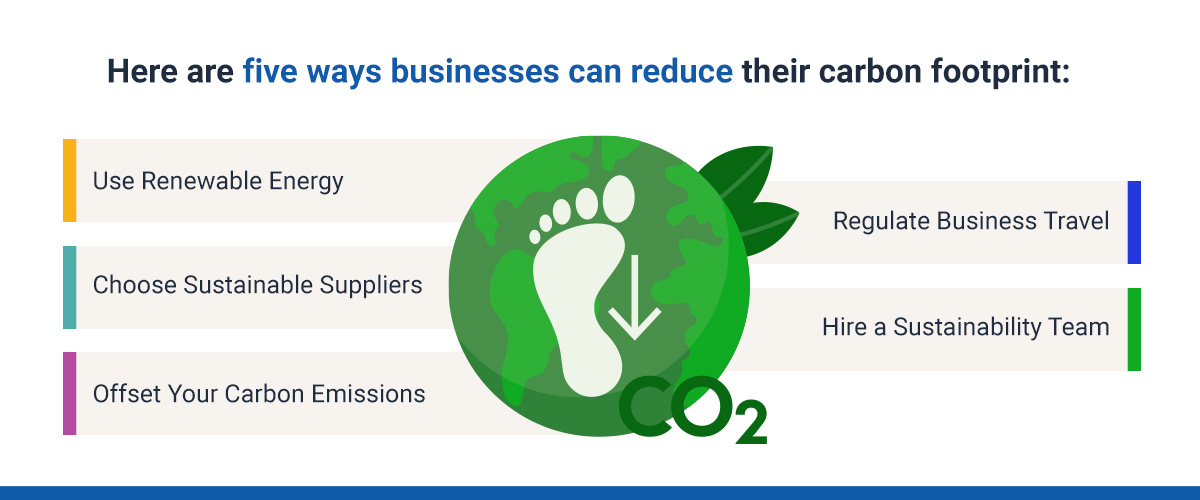Running a business involves various practices and activities that might impact its carbon footprint. Finding ways to improve your sustainability standards and knowledge may be crucial to enhancing the company’s public image as consumers begin to value eco-friendly practices more. This guide explores what a business carbon footprint is, how to calculate it and ways to reduce your company’s carbon footprint.
What Is a Carbon Footprint in Business?
Business carbon footprint is the total greenhouse gases (GHG) an organization, product, service or person directly or indirectly produces on the planet. For instance, businesses might increase their carbon footprint through excessive electricity use, fossil fuel burning, company transport and other generated waste.
The carbon footprint of your business typically only involves carbon emissions related to your business, which may include energy produced from employees traveling to work, delivering products to destinations and producing energy from the products or services you offer your consumers.
What Is the Average Business Carbon Footprint?
While there are few clear indications of the average business carbon footprint in the United States, there are some noteworthy statistics about business carbon footprints. The average carbon footprint for electric power generation companies may include 97.8% direct emissions and 2.2% indirect emissions. In contrast, the average carbon footprint for wholesale and retail trade companies may include 1.3% direct emissions and 98.7% indirect emissions.
This shows a company’s specific carbon footprint will depend on its industry and the particular impact of its operations and products or services. A company’s carbon footprint can also vary based on the state it operates in. This is because different states’ fuel usage can vary depending on state policies created to reduce emissions, building standards, energy resources available and the types of businesses that are most popular in the state’s economy.
How to Calculate Your Business’s Carbon Footprint
You can calculate your business’s carbon footprint by multiplying your activity or consumption data by the corresponding emission factor. The emission factor is the amount of greenhouse gases emitted from an activity, while the consumption or activity data is the activity level that generates greenhouse gas emissions. There are three main scopes of activity data, including:
- Scope 1: This includes greenhouse gas emissions a company has direct control over, such as those from refrigerant systems, manufacturing, on-site waste facilities and fuel consumption through process equipment, heating and vehicles.
- Scope 2: Scope 2 involves the company’s indirect emissions through energy consumption consumed and acquired by the organization, including equipment, lighting and water heaters.
- Scope 3: These include greenhouse gases the organization may not control but can influence. Examples include emissions caused by employees commuting to work, transporting materials for products and business travel.
How Can Businesses Reduce Their Carbon Footprint?
While every company may need energy to run processes, create products and provide services, there are some steps you can take to reduce your company’s carbon emissions. Here are five ways businesses can reduce their carbon footprint:

1. Use Renewable Energy
One of the first ways to reduce your business’s carbon footprint is by using renewable energy to run the company. Renewable energy can include solar and wind power, which are natural resources that can replenish themselves faster than they are used. Begin checking with your current provider about whether they offer renewable energy plans. Otherwise, you may check with other providers who can guarantee their power only comes from renewable sources.
Research which green energy sources work best for your industry and verify whether your chosen energy provider’s fuel mix used for your business only includes green sources.
2. Choose Sustainable Suppliers
Unsustainable suppliers might be a significant source of your scope 3 emissions. For example, if you get most of your raw or finished materials from these types of suppliers, while your company hasn’t produced them itself, it is indirectly responsible for the emissions the supplier used to make and deliver those materials.
This makes it helpful to switch to sustainable suppliers that use eco-friendly methods. You may ensure this by checking whether they have ISO 14001 certification, which proves that the supplier is actively working toward improved resource efficiency and uses sustainable methods for its Quality Management Systems. Ask the supplier directly for their carbon emissions data before moving forward with them.
3. Offset Your Carbon Emissions
Investing in carbon offsetting is an effective way to further reduce your carbon footprint when finding sustainable alternatives in certain areas of your business is challenging. Carbon offsetting is when you invest in an approved project, such as reforestation programs or renewable energy investments, that aims to combat the effects of global warming to compensate for your carbon emissions.
While your company is reducing its carbon footprint, it also gets to give back to the community, which may help you gain new and repeat customers. Choose a sustainable project that might resonate with your target audience and partner with an organization with a steady following. Doing so may help you gain more customers.
4. Regulate Business Travel
According to the Environmental Protection Agency (EPA), 29% of U.S. greenhouse gas emissions are due to transportation, making it the third largest contributor of gas emissions in the U.S. Rethinking your company’s travel policy may be an excellent opportunity for reducing its carbon footprint. For instance, you might:
- Switch to hybrid or electric company vehicles.
- Provide hybrid or remote work opportunities for employees to reduce their carbon footprint from traveling to work.
- Use ride-sharing services for business trips.
- Switch from flying to bus and train trips.
- Encourage biking and carpooling to work.
5. Hire a Sustainability Team
Incorporate a sustainability team with a knowledgeable manager or chief officer to develop an effective strategy. These professionals may be well-versed in the fluidity of the company’s carbon footprint, review internal processes, create achievable sustainability goals and monitor the progress of strategies throughout the year. This offers an excellent way for you and the rest of your employees to focus on core tasks.
Reduce Your Business’s Carbon Footprint With UtiliSave, LLC
It helps to get a more accurate picture of where you might reduce your company’s carbon footprint, especially if you need to track where your indirect impacts are coming from. Fortunately, UtiliSave, LLC, is an industry expert in utility bill cost recovery and helping organizations boost their Environmental, Social and Governance (ESG) ratings.
Our specialists collaborate with your business’s ESG or sustainability team and use our numerous resources and expertise to review hundreds of thousands of data points from your utility provider to identify usage and billing errors that negatively affect sustainability metrics and enhance your company’s energy management practices. For assistance in reducing your business’s carbon footprint, contact our experts today.



